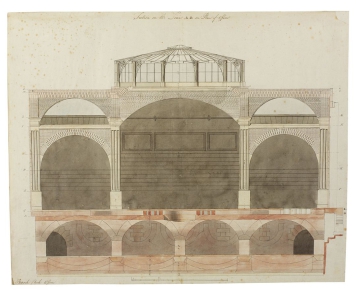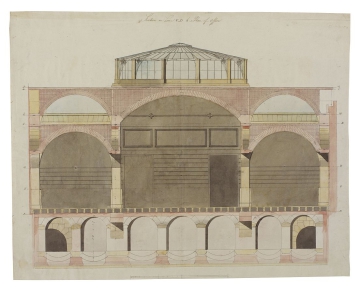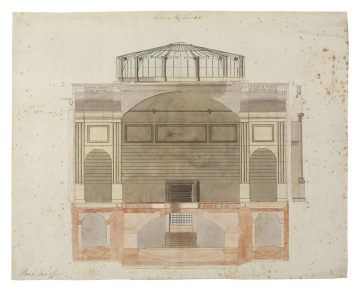
Browse
Reference number
Purpose
Aspect
Scale
Inscribed
Signed and dated
- (20-22) datable to 1792
Medium and dimensions
Hand
Notes
Beneath the flooring of drawing 20 the ducts of the heating system can be seen in the centre and to the right the timber framing of the floor can be seen. The inverted segmental arches at the bottom of the three drawings make up the base layer of the foundation.
In drawings 21 and 22 particular attention is paid to the structure of the piers and the various courses in the vaulting of bricks and hollow-cone pots, whereas drawing 21 focuses more on the cellar foundations.
Significantly drawing 21 shows the lateral arches to have been constructed as segmental arches, but given semi-circular profiles by extending the line of the arch beneath the projecting impost bricks. Soane was less concerned with expressing structure than achieving just the right aesthetic balance. Set into these impost blocks, as well as the clerestory ones above, are iron tie rods, shown as thin, blue rectangles, similarly shown in drawings 28-29.
In the three drawings there appear jointed segments of rods or piping on the walls beneath the central arch, whose function is unclear (and were unrealised), but may be related to drains seen in the plan of the roof (see drawing 28).
Drawing 22 shows the contrast between the open framing of the centre-aisle floor and the solid flooring beneath the side-aisles to support the weight of the piers (see drawing 45). Above the grilled door in the north wall of the cellar is the fireplace, part of the heating system for the hall (see drawing 45).
Literature
Level
Sir John Soane's collection includes some 30,000 architectural, design and topographical drawings which is a very important resource for scholars worldwide. His was the first architect’s collection to attempt to preserve the best in design for the architectural profession in the future, and it did so by assembling as exemplars surviving drawings by great Renaissance masters and by the leading architects in Britain in the 17th and 18th centuries and his near contemporaries such as Sir William Chambers, Robert Adam and George Dance the Younger. These drawings sit side by side with 9,000 drawings in Soane’s own hand or those of the pupils in his office, covering his early work as a student, his time in Italy and the drawings produced in the course of his architectural practice from 1780 until the 1830s.
Browse (via the vertical menu to the left) and search results for Drawings include a mixture of Concise catalogue records – drawn from an outline list of the collection – and fuller records where drawings have been catalogued in more detail (an ongoing process).






